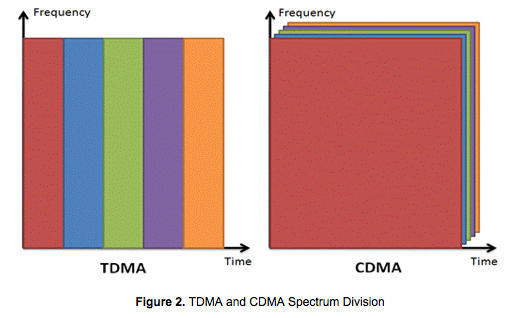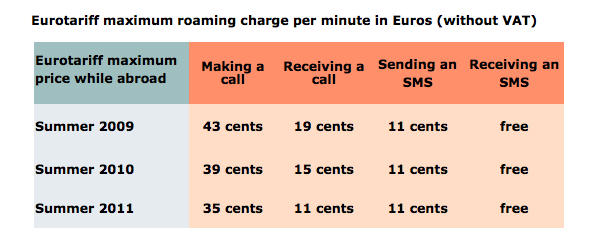Affiliate links on Android Authority may earn us a commission. Learn more.
How it Works: Roaming
Published onJune 18, 2012
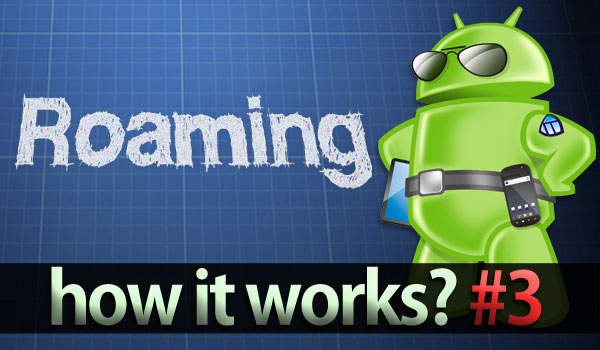
When choosing your next Android smartphone you should be taking into account a variety of factors before committing to a single model. Some of these factors are screen size and screen technology, processor speed, 3G/4G support, camera performance, operating system, and upgradability to future versions and world phone support.
Today we’re going to focus on that last feature, global roaming, and we’re going to tell you how roaming works, because this is definitely a very important feature, especially for smartphone buyers that have to travel on a regular basis to various countries and keep using their smart devices in the process.
What is Roaming?
Roaming is a term you often hear when dealing with your carrier, especially when wondering why it costs so much. In short, roaming is a term used to describe the ability of phones to connect to the network of a different carrier, abroad or at home in order to offer users the same features they use while on their “home” network – making and receiving calls and text messages and surfing the web. Roaming is possible thanks to the international agreements carriers have with other carriers, in order to offer their wireless services in other regions of a country or of the world.
There are various types of roaming agreements between carriers, with some of them being free, but most of them will bring extra charges to your monthly cell phone bill. Also worth remembering is that roaming services have to be activated with some carriers in order for your phone to work abroad. So, if you plan to use the handset in other countries, you’ll have to enable the service with your mobile operator before departing.
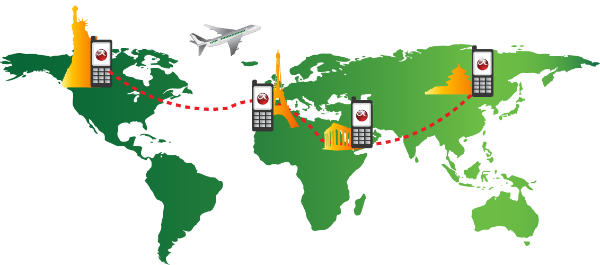
When thinking about roaming, we generally refer to using the handset in a different country – international roaming. But the same term can refer to regional roaming, when users will be roaming when moving from one region of a country to another, without switching carriers in the process, or national roaming, when moving from carrier A to carrier B inside the same country while still being a subscriber with carrier A (not to be confused with porting the number to carrier B), although this is something you may not want to do, or if you’re doing it you may be unaware of it happening.
When roaming, users pay for making calls, receiving calls, sending text messages, receiving text messages (not in all cases) and connecting to the Internet. Furthermore, when making calls and sending text messages or data, these won’t be taken from whatever voice minutes, text messages and data cap your current plan offers each month while at home. These charges will appear on your bill in addition to your regular monthly subscription, and the tariffs are (much) higher than local tariffs.
How does Roaming work?
In order for roaming to work, there are two components involved, the carriers and the phone.
The Phone
In order for the phone to be able to connect to wireless mobile operators, other than the one it was purchased from initially, the device must be compatible with the wireless network used by those carriers. In other words, a CDMA phone may not connect to a GSM network abroad, therefore Verizon and Sprint customers may find out that their handset can’t be used in Europe or in other international markets.
Similarly, not all GSM networks operate on the same bands, therefore not all GSM handsets can be used anywhere on Earth, so you should definitely pay attention to your handset’s connectivity characteristics in case you plan to roam a lot.
If you think 4G LTE connectivity will fix that problem, you should know that not all carriers that are adopting the next-gen wireless standard will use the same spectrum for LTE support, which means that not all LTE handsets will have 4G LTE coverage wherever LTE support is available. But we’ll tackle that problem once LTE becomes available in more and more markets
The Carriers
In addition to the phone’s connectivity features, you also need two carriers to make roaming work, your home carrier and the visited carrier. The two mobile operators have to be bound by a mutually beneficial roaming agreement that lets one’s subscribers use roaming when under the other’s coverage. But don’t worry, most carriers, if not all, already have such agreements in place with most carriers, if not with all.
Why is it so important for them to offer roaming features? First of all, it’s all about marketing. Each carrier, especially major ones, want their subscribers to know that they’ll be able to use the handset, which is purchased in most cases for a subsidized two-year contract, abroad and enjoy the same services. And second of all, roaming agreements between carriers aren’t exactly controlled by a regulator (except in the EU), which means that mobile operators can jack up prices and raise their profit margins when it comes to charging for used voice minutes, SMS and MMS messages, and especially data used when roaming.
Even so, because mobile devices and mobile technology did not appear all of a sudden everywhere at the same time, there are various instances in which certain phones will not work in other countries, and we’re going to tell you why that happens in what follows.
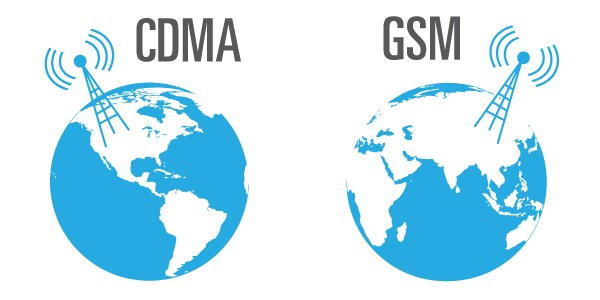
GSM, CDMA, MVNO, VoIP – What does it all mean?
The acronyms above are very important when it comes to roaming and controlling roaming costs, and, while we won’t get into the technical stuff behind each one, we’re going to explain them to you so you know what carrier you should be choosing next time you’re buying a phone, and especially a smartphone.
GSM
GSM is short for Global System for Mobile Communications and it describes a wireless communication standard developed in the early 1980s to replace the 1G analog cellular networks available at the time. Technically, GSM, now a standard that is overseen by the European Telecommunications Standards Institute, was supposed to describe the second-generation digital network, but the term is now used to also describe 3G and 4G LTE standards.
The good news for most smartphone users is that around 80% of worldwide carriers use GSM technology and provide wireless services to over 5 billion potential customers in more than 212 countries. That’s also great news for handset manufacturers, as they don’t have to keep changing the internal components of their devices to offer support to as many carriers.
However, there are certain things you should be aware of before buying a GSM handset.
First of all, not all mobile operators in the world operate on the same frequencies, which means that your phone won’t be able to roam internationally. European operators operate on the 900MHz, 1800MHz, and 2100MHz bands while U.S. GSM carriers (AT&T and T-Mobile) operate on the 850MHz, 1700MHz, 1900MHz, and 2100MHz. In order for a handset sold in Europe to work in the U.S. and vice-versa, buyers should pay attention to how many bands the handset supports. A good rule of thumb is choosing a tri-, quad-, or penta-band handset, as it will be able to support three, four or five of the frequencies mentioned above and thus offer roaming support.
In fact, you should know that even AT&T and T-Mobile have different GSM bands, and certain AT&T customers that have unlocked their devices to use them on T-Mobile can’t connect to the carriers 3G and “fake” 4G networks.
Finally, one thing that’s characteristic for all GSM handsets is that they require a SIM card (no matter what size) to operate. The SIM card, short for Subscriber Identity Module, is used to store the user’s carrier information and can be moved from handset to handset, with the user being able to hold on their phone number even when upgrading phones. Moreover, GSM users can move from one GSM carrier to an other and retain their phone number even after changing providers, although there may be costs involved when doing so.
The use of SIM cards makes it possible for users to use a prepay SIM card in other countries instead of using their original SIM, in order to save money on their cellular bill by avoiding costly roaming charges. That’s only possible after unlocking the phone, especially if it was purchased with contract, and it may involve additional costs. Also worth mentioning is that by using a local SIM card, you’d get a local phone number instead of your home number.
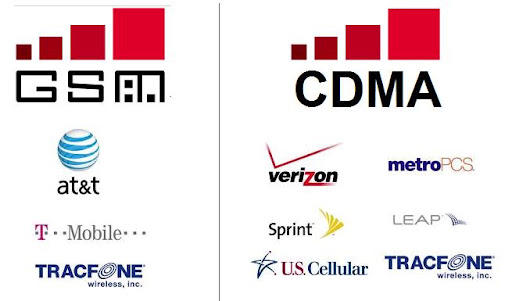
CDMA
While AT&T and T-Mobile are the main GSM carriers in the USA, Verizon and Sprint are the main CDMA mobile operators in the region. As you may have guessed by now, CDMA is a different wireless communication technology, but it’s not as popular with carriers especially outside of the USA. In fact, Verizon and Sprint are the main CDMA carriers in the world, and since CDMA use is not as widespread as GSM, Verizon and Sprint customers may find themselves unable to use roaming services in other countries because GSM and CDMA are not compatible.
CDMA stands for Code Division Multiple Access, and it describes the way data is converted in radio waves that are transmitted and received by CDMA handsets. The difference between CDMA and GSM is that CDMA stacks calls one on top of the other when transporting them through the air, making use of all the available spectrum and then unpacks them when they reach their destination while GSM divides the available spectrum into various time-based channels that can be used to place multiple simultaneous calls.
One of the advantages of CDMA over GSM is that the dropped calls rate is lower, but the downside is CDMA handsets don’t have simultaneous voice and data support like their GSM counterparts, which means CDMA smartphone owners can’t browse the web and talk on the phone at the same time. Not to mention that third-generation CDMA data speeds are theoretically and practically inferior to GSM 3G and 3.5+G (fake 4G) networks.
Moreover, CDMA handsets come without a SIM card. Instead they are programmable by the operator which makes switching phones or carriers difficult. Those CDMA devices that have SIM cards are called global phones, and they’re the ones that will offer roaming support in GSM markets. Therefore, these are the handsets you should be looking for in Verizon and Sprint stores in case you’re planning to do plenty of roaming in GSM markets.
Not all CDMA handsets have GSM support (they are not global phones), although we expect more and more smartphones launched by the two carriers to come with GSM capabilities.
And in case you are wondering, Verizon’s and Sprint’s 4G LTE smartphones use both CDMA and GSM technology (LTE is considered a GSM version) but that doesn’t mean they’ll connect to 3G GSM networks in other regions. Also worth mentioning is that other acronyms such as TDMA (see image above) or W-CDMA (UMTS), actually refer to GSM technology and not CDMA.
MVNO
You seldom hear this acronym because it does not stand for a mobile communication technology. But it’s still important, especially if you plan to save on your cell phone bills, and even more so if you plan on saving precious cash when traveling.
MVNO stands for Mobile Virtual Network Operator and describes a carrier that does not own its own spectrum, towers and all the other wireless equipment that makes mobile phone work. But such carriers can still offer the same wireless services regular operators have to offer. Such is the case of Virgin Mobile in the USA, which uses Sprint spectrum – in fact, it’s a Sprint-owned company now but that wasn’t always the case.
That’s possible because MVNOs buy network services in bulk from a regular carrier and then resell them to end-users, usually for cheaper prices than that carrier. That’s still profitable for MVNOs because they don’t have to pay anything for the upkeep and modernization of the wireless network they’re using, therefore they can afford to lower the rates on voice calls, messages and data in order to attract more customers. Usually, they usually offer quite affordable pre-pay rates for these services and that’s definitely worth remembering.
As for regular carriers, without getting into too much detail, they’re still happy to make a profit from selling their services to MVNOs, even though they’re basically creating competitors with more customer-friendly offers – in some markets, governments require carriers to support MVNOs in order to create a competitive environment in the local mobile business.
MVNOs can be great alternatives to roaming, especially if we’re talking about GSM-based companies that can support your GSM smartphone.
VoIP
Voice over Internet Protocol, is a communication protocol that lets certain companies such as Skype (and there are plenty of others) use the Internet in order to offer wireless services such as phone calls, instant messages and data transfers by using an available Internet connection. Whether we’re talking about a cable, Wi-Fi or even 3G/4G connection, VoIP programs can often replace carriers when it comes to communication alternatives and they will usually offer lower rates than carriers for such services.
Instead of roaming, smartphone users that travel abroad on a regular basis could consider using VoIP programs for their phone call and message needs in order to save some money on their carrier bill. However, they’ll have to refrain from using roaming data for VoIP calls, since the roaming data still comes at a premium price.
In case you’re wondering, there’s no VoIP-based carrier out there, but we shouldn’t be surprised to see mobile operators invest more in VoIP in the future.
Why does Roaming cost so much?
Now that you know how roaming works, you should better understand that carriers can pretty much do whatever they please when setting up roaming fees and why you should avoid them whenever possible – unless someone else is paying for the phone bill – and try to use alternatives when traveling.
If you’re based in any European country part of the European Union you’ll be happy to hear that the EU decided to step in and regulate roaming costs and all carriers in the Union must abide to those rules. The current roaming costs, which have been on a downwards path for a few years now, are as follows:
Furthermore, these prices are expected to be lowered again in the near future.
As you can see, roaming is a pretty important feature for all mobile devices users out there, whether we’re talking about regular phone owners or smartphone buyers. In case you have to make a lot of work-related traveling, or you’re a hardcore tourist, you should have a better understanding of your phone’s roaming capabilities and of the costs involved before using voice calls, texts and data in other countries.
If possible, avoid roaming by using a local pre-pay SIM card, and get it from a MVNO rather than a regular carrier. Moreover, remember to rely on Wi-Fi, which is available virtually anywhere you’d travel to, for your data needs, and to switch off mobile data when traveling. GPS use is free of charge and will not incur roaming costs if used with special GPS apps. In case you use GPS with online services, then the map data your handsets downloads will cost you no matter whether you’re using roaming data or a local pre-pay card.
Have you been roaming much? Feel free to voice any questions and we’ll do our best to answer!
